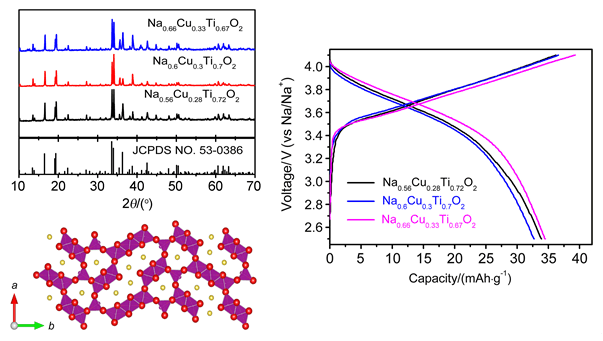| [1] Lyu, Z. Y.; Feng, R.; Zhao, J.; Fan, H.; Xu, D.; Wu, Q.; Yang, L. J.; Chen, Q.; Wang, X. Z.; Hu, Z. Acta Chim. Sinica 2015, 73, 1013. (吕之阳, 冯瑞, 赵进, 范豪, 徐丹, 吴强, 杨立军, 陈强, 王喜章, 胡征, 化学学报, 2015, 73, 1013.)
[2] Hua, W.; Wang, Y.; Zhong, Y.; Wang, G.; Zhong, B.; Fang, B.; Guo, X.; Liao, S.; Wang, H. Chin. J. Chem. 2015, 33, 261.
[3] Ou, J.; Yang, L.; Zhang, Y.; Chen, L.; Guo, Y.; Xiao, D. Chin. J. Chem. 2015, 33, 1293.
[4] Armand, M.; Tarascon, J. M. Nature 2008, 451, 652.
[5] Wang, Y. S.; Rong, X. H.; Xu, S. Y.; Hu, Y. S.; Li, H.; Chen, L. Q. Energy Storage Science and Technology 2016, 5, 268. (王跃生, 容晓晖, 徐淑银, 胡勇胜, 李泓, 陈立泉, 储能科学与技术, 2016, 5, 268.)
[6] Pan, H. L.; Hu, Y. S.; Chen, L. Q. Energy Environ. Sci. 2013, 6, 2338.
[7] Li, H.; Wu, C.; Wu, F.; Bai, Y. Acta Chim. Sinica 2014, 72, 21. (李慧, 吴川, 吴锋, 白莹, 化学学报, 2014, 72, 21.)
[8] Xiang, X.; Zhang, K.; Chen, J. Adv. Mater. 2015, 27, 5343.
[9] Wu, D.; Li, X.; Xu, B.; Twu, N.; Liu, L.; Ceder, G. Energy Environ. Sci. 2014, 8, 195.
[10] Hamani, D.; Ati, M.; Tarascon, J.-M.; Rozier, P. Electrochem. Commun. 2011, 13, 938.
[11] Kubota, K.; Ikeuchi, I.; Nakayama, T.; Takei, C.; Yabuuchi, N.; Shiiba, H.; Nakayama, M.; Komaba, S. J. Phys. Chem. C 2015, 119,166.
[12] Li, Y.; Feng, X.; Cui, S.; Shi, Q.; Mi, L.; Chen, W. CrystEngComm 2016, 18, 3136.
[13] Lee, E.; Brown, D. E.; Alp, E. E.; Ren, Y.; Lu, J.; Woo, J.-J.; Johnson, C. S. Chem. Mater. 2015, 27, 6755.
[14] Reddy, B. V. R.; Ravikumar, R.; Nithya, C.; Gopukumar, S. J. Mater. Chem. A 2015, 3, 18059.
[15] Han, M.; Gonzalo, E.; Casas-Cabanas, M.; Rojo, T. J. Power Sources 2014, 258, 266.
[16] Liu, Y.; Fang, X.; Zhang, A.; Shen, C.; Liu, Q.; Enaya, H. A.; Zhou, C. Nano Energy 2016, 27, 27.
[17] Zhu, Y.-E.; Qi, X. G.; Chen, X.; Zhou, X.; Zhang, X.; Wei, J.; Hu, Y.; Zhou, Z. J. Mater. Chem. A 2016, 4, 11103.
[18] Qi, X.; Wang, Y.; Jiang, L.; Mu, L.; Zhao, C.; Liu, L.; Hu, Y.-S.; Chen, L.; Huang, X. Part. Part. Syst. Charact. 2016, 33, 538.
[19] Guo, H.; Wang, Y.; Han, W.; Yu, Z.; Qi, X.; Sun, K.; Hu, Y.-S.; Liu, Y.; Chen, D.; Chen, L. Electrochim. Acta 2015, 158, 258.
[20] Delmas, C.; Fouassier, C.; Hagenmuller, P. Physica B & C 1980, 99, 81.
[21] Doeff, M. M.; Richardson, T. J.; Hollingsworth, J.; Yuan, C. W.; Gonzales, M. J. Power Sources 2002, 112, 294.
[22] Doeff, M. M.; Peng, M. Y.; Ma, Y.; De Jonghe, L. C. J. Electrochem. Soc. 1994, 141, L145.
[23] Parant, J.-P.; Olazcuag, R.; Devalett, M.; Fouassie, C.; Hagenmuller, P. J. Solid State Chem. 1971, 3, 1.
[24] Whitacre, J. F.; Tevar, A.; Sharma, S. Electrochem. Commun. 2010, 12, 463.
[25] Wang, Y.; Liu, J.; Lee, B.; Qiao, R.; Yang, Z.; Xu, S.; Yu, X.; Gu, L.; Hu, Y. S.; Yang, W.; Kang, K.; Li, H.; Yang, X. Q.; Chen, L.; Huang, X. Nat. Commun. 2015, 6, 6401.
[26] Wang, Y.; Mu, L.; Liu, J.; Yang, Z.; Yu, X.; Gu, L.; Hu, Y. S.; Li, H.; Yang, X. Q.; Chen, L.; Huang, X. Adv. Energy Mater. 2015, 5, 1501005.
[27] Xu, S.; Wang, Y.; Ben, L.; Lyu, Y.; Song, N.; Yang, Z.; Li, Y.; Mu, L.; Yang, H.-T.; Gu, L.; Hu, Y.-S.; Li, H.; Cheng, Z.-H.; Chen, L. Huang, X. Adv. Energy Mater. 2015, 5, 1501156.
[28] Wang, J.; Qiu, B.; He, X.; Risthaus, T.; Liu, H.; Stan, M. C.; Schulze, S.; Xia, Y.; Liu, Z.; Winter, M.; Li, J. Chem. Mater. 2015, 27, 4374.
[29] Zhan, P.; Wang, S.; Yuan, Y.; Jiao, K.; Jiao, S. J. Electrochem. Soc. 2015, 162, A1028.
[30] Jiang, X.; Liu, S.; Xu, H.; Chen, L.; Yang, J.; Qian, Y. Chem. Commun. 2015, 51, 8480.
[31] Chu, Q.; Wang, X.; Li, Q.; Liu, X. Acta Crystallogr. Sect. C 2011, 67, i10.
[32] Kim, H.; Kim, D. J.; Seo, D.-H.; Yeom, M. S.; Kang, K.; Kim, D. K. Jung, Y. Chem. Mater. 2012, 24, 1205.
[33] Xu, S. Y.; Wu, X. Y.; Li, Y. M.; Hu, Y. S.; Chen, L. Q. Chin. Phys. B 2014, 23, 118202.
[34] Mu, L.; Xu, S.; Li, Y.; Hu, Y.-S.; Li, H.; Chen, L.; Huang, X. Adv. Mater. 2015, 27, 6928.
[35] Mu, L.; Hu, Y.-S.; Chen, L. Chin. Phys. B 2015, 24, 038202.
[36] Li, Y.; Yang, Z.; Xu, S.; Mu, L.; Gu, L.; Hu, Y.-S.; Li, H.; Chen, L. Adv. Sci. 2015, 2, 1500031.
[37] Li, Y.; Hu, Y.-S.; Qi, X.; Rong, X.; Li, H.; Huang, X.; Chen, L. Energy Storage Mater. 2016, 5, 191.
[38] Sharma, N.; Gonzalo, E.; Pramudita, J. C.; Han, M. H.; Brand, H.; Hart, J. N.; Peng, W. K.; Guo, Z. P.; Rojo, T. Adv. Funct. Mater. 2005, 25, 4994. |
